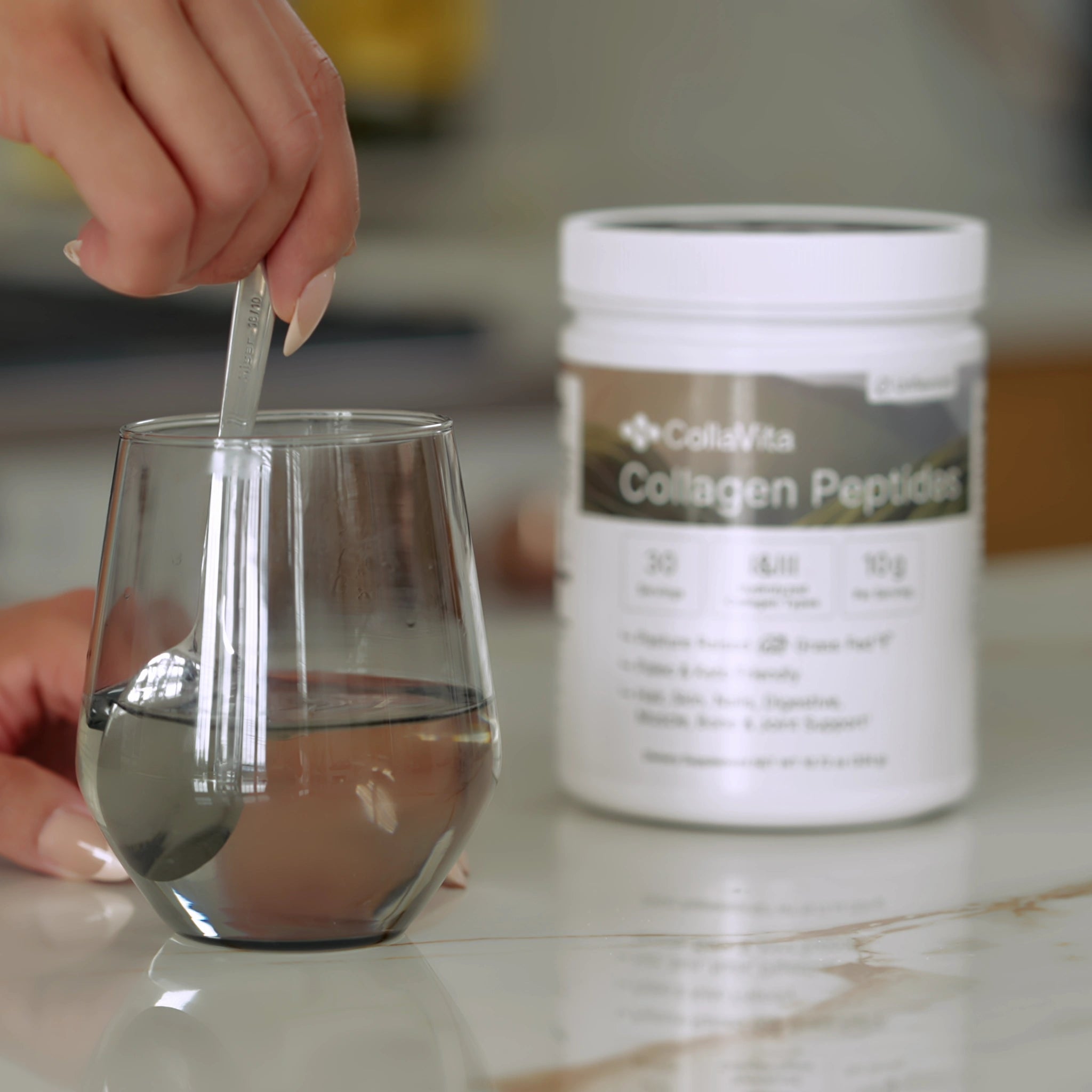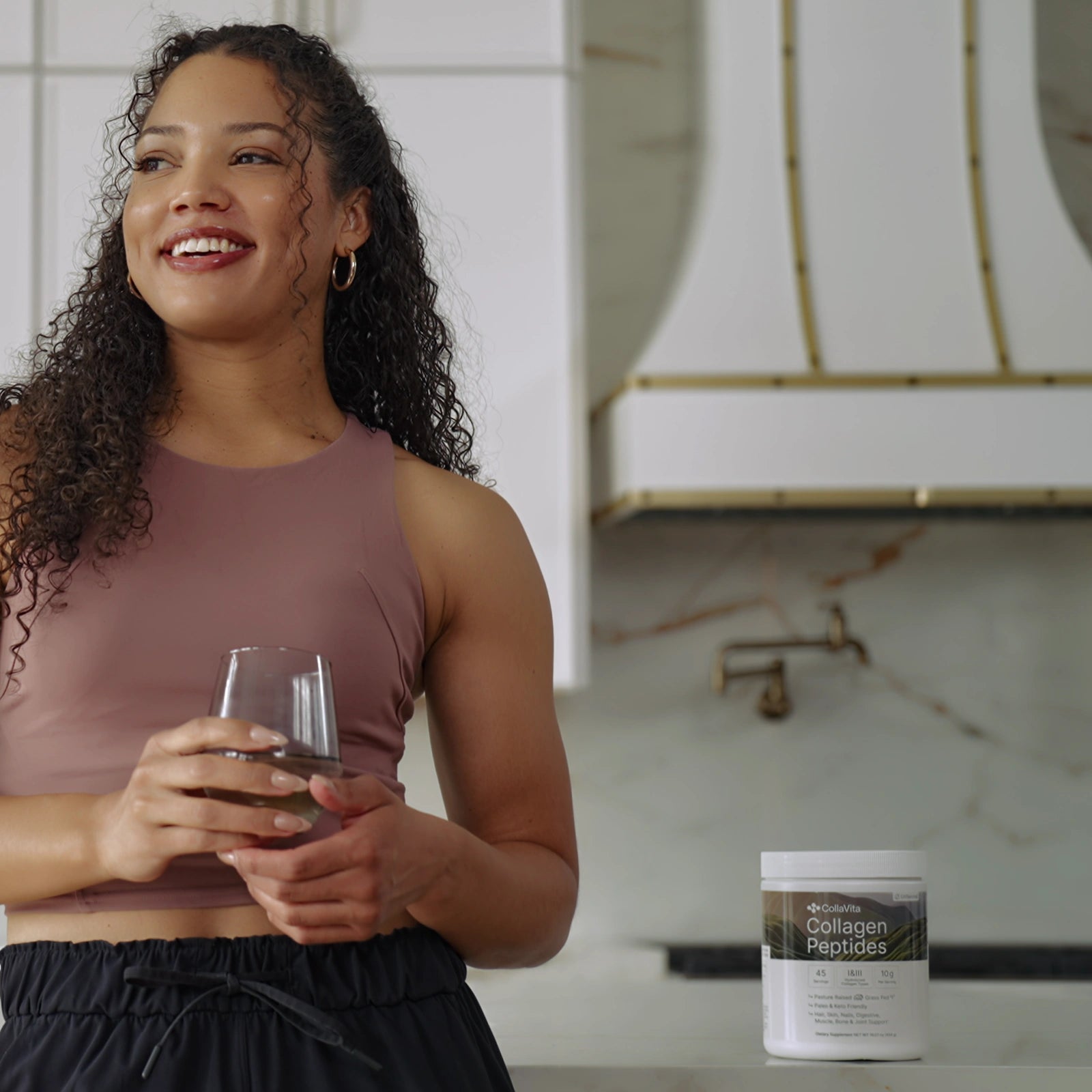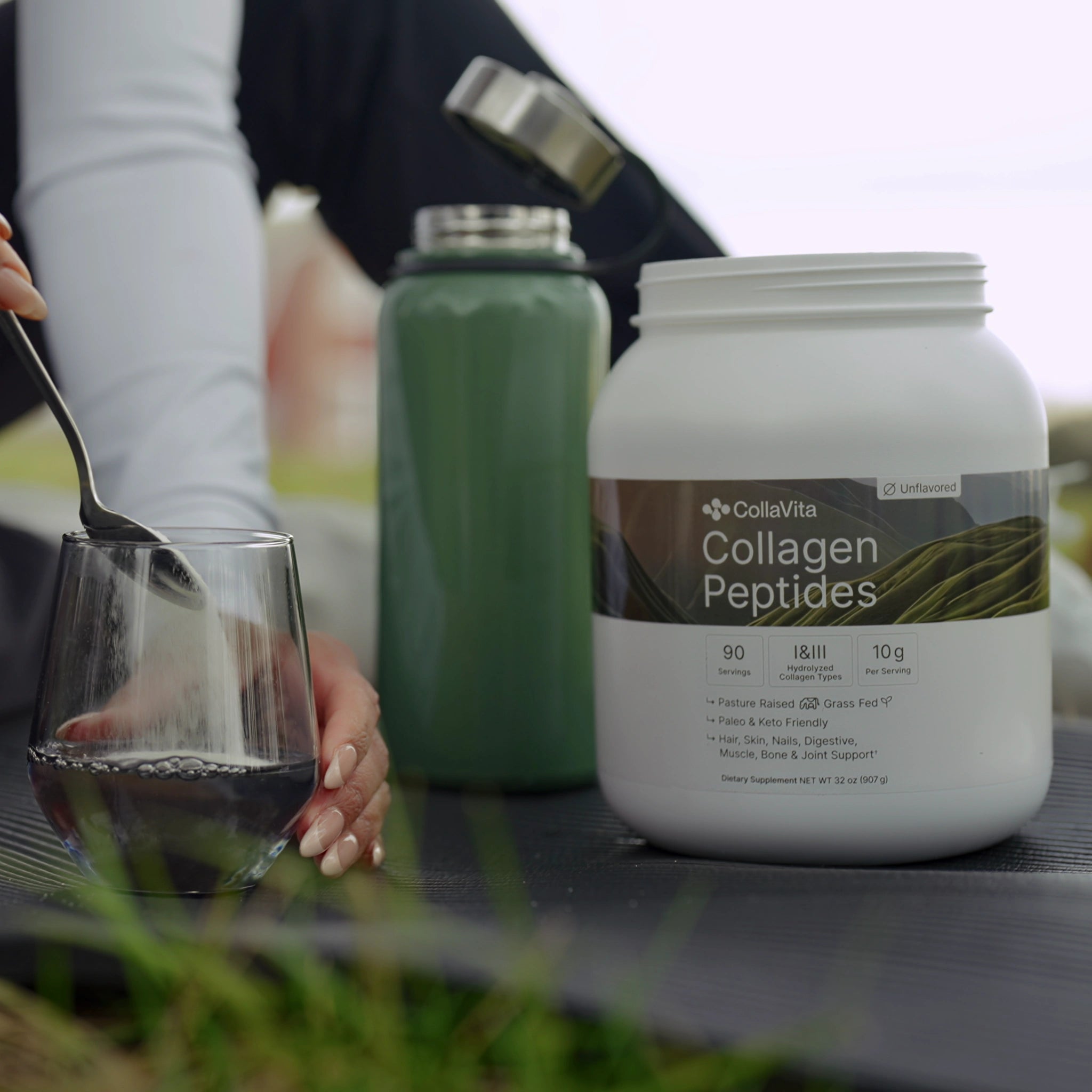Collagen is a natural protein that is a crucial connective tissue for the strength and health of your skin, muscles, bones, tendons, ligaments, and skin. All types of collagens feature a triple helix structure that is made of three amino acids: glycine, proline, and hydroxyproline. This protein improves cellular activity to support tissue repair, maintain skin elasticity, and protect cell and organ functions. Collagen is the most abundant protein in the human body, comprising approximately 30% of the total protein mass in mammals. A study by Sylvie Ricard-Blum, Professor of Biochemistry at the University of Lyon, published in Cold Spring Harbor Perspectives in Biology¹, underscores its critical role in structural and functional integrity.
There are 28 different types of collagen identified so far, but most of the collagens that are present in the human body are Type I, Type II, Type III, Type IV, and Type V collagens. Each of these collagen types has a different structure and, therefore, plays a significant role in other functions and processes. Hence, we will focus on these 5 main types of collagens with their functions and benefits in the human body.

What is Type I Collagen?
Type 1 Collagen is the most common type of protein in the human body and makes up almost 90% of all collagen in the body. It also has a triple helix structure, but one of the chains has proline and hydroxyproline amino acids. Collagen Type 1 is predominantly found in the skin, eyes, vasculature, and tendons, known for its low immunogenicity, high biocompatibility, and antioxidant properties. A 2021 study by Naomi et al., published in the Journal of Bioengineering², highlights its extensive applications as a tissue repairer, wound healer, and biomaterial.
Collagen Type 1 plays a key role in enhancing skin elasticity, reducing wrinkles, and combating dehydration and irritation. While the human body naturally produces Collagen Type 1, its production decreases after the twenties. To replenish collagen levels, collagen-rich foods and supplements can provide essential support when dietary intake alone is insufficient. These findings are highlighted in a 2021 study by Hwang et al., titled Collagen Type I for Skin Health: A Critical Review, published in BMB Reports³.

What is Type II Collagen?
Type 2 Collagen is another type of Collagen which features looser fibers. It is mostly found in cartilage, retina, and intervertebral disks as a cushion between joints and allows movement through smoother functioning. However, its chief location is the cartilage since it forms the significant structural material for joints as a connective tissue of cartilage.
Collagen Type 2 is essential for cartilage function and growth, making it a common treatment option for cartilage-related conditions such as knee osteoarthritis and rheumatoid arthritis. It has been shown to alleviate joint pain during walking and improve the quality of life for patients with knee osteoarthritis. These findings are detailed in a study by Bakilan et al., titled Effects of Native Type II Collagen Treatment on Knee Osteoarthritis: A Randomized Controlled Trial, published in the Eurasian Journal of Medicine⁴.

What is Type III Collagen?
Collagen Type 3 constitutes 5–20% of all collagen in the human body and plays a crucial role in maintaining the integrity of organs and tissues. These insights are highlighted in the study by Helena Kuivaniemi and Gerard Tromp, titled Type III Collagen (COL3A1): Gene and Protein Structure, Tissue Distribution, and Associated Diseases, published in ScienceDirect⁵.
Type 3 Collagen synergizes with Type 1 Collagen to support tissues and organs, contributing to skin elasticity, wound healing, and overall flexibility and strength. These collagens provide tensile strength and enhance muscle elasticity while promoting effective wound healing. These findings are detailed in a 2023 study by Singh et al. published in Fortune Journals⁶.
What is Type IV Collagen?
Maintaining Collagen Type IV levels in the basement membrane enhances the skin’s resistance to external impacts and promotes overall skin health. These findings are discussed in the 2024 article published in International Journal of Molecular Sciences⁷.
What is Type V Collagen?
Type 5 Collagen has a minor presence in the human body and is scattered widely in the cornea, placental membranes, bone, and large vessels. It works with Collagen Type 1 and Collagen Type 3 to create heterofibrils. This process is detailed in the book Biochemistry of Collagens, Laminins and Elastin⁸, available on ScienceDirect ScienceDirect - Biochemistry of Collagens, Laminins and Elastin.
Collagen Type V is present in the skin, veins, arteries, and membranes, where it plays a critical role in supporting network formation and linking fibrillar collagens. These insights are highlighted in a study by Mak et al., published in The Anatomical Record Wiley⁹.
What Are The Best Sources Of Collagen?
Collagen, primarily derived from animal-based foods, is essential for organ function, flexible skin, and sharp vision, with unique roles in elasticity, network formation, wound healing, and inflammation reduction. However, collagen production begins to decline in the mid-twenties and accelerates after age 40, with an annual loss of approximately 1%. These findings are detailed in the article Hydrolyzed Collagen—Sources and Applications, published in Molecules¹⁰. Hence, you must boost collagen intake by increasing the consumption of:
- Bone broth
- Chicken
- Fish
- Eggs
- Berries
- Broccoli
- Beef
- Salmon
- Sardines
Furthermore, there are also collagen supplements that are available as hydrolyzed to ensure the maximum absorption of collagen types into your body. Or, you can prefer collagen-containing creams, gels, and injections, particularly for skin health.

Why do I need collagen?
Collagen helps our tissues maintain their firmness and elasticity, thereby providing wrinkle-free and glowing skin. Furthermore, different types of collagen constitute the basic compounds of various bones, organs, and tissues throughout the human body and ensure their proper functioning. However, as we age, collagen degrades and causes saggy skin and wrinkles. Therefore, it becomes a necessity to provide additional collagen to our body through collagen-rich foods and supplements for the best types of collagen.
Who should use collagen?
People who have joint pain, osteoarthritis, or concerns over their bone health should use collagen. Furthermore, collagen is necessary for those who want to improve their skin firmness and reduce wrinkles. Additionally, collagen helps athletes and physically active people enhance their tendon and ligament health.
SOURCE
(1)- Ricard-Blum S. The collagen family. Cold Spring Harb Perspect Biol. 2011 Jan 1;3(1):a004978. doi: 10.1101/cshperspect.a004978. PMID: 21421911; PMCID: PMC3003457.
(2)- Naomi R, Ridzuan PM, Bahari H. Current Insights into Collagen Type I. Polymers (Basel). 2021 Aug 9;13(16):2642. doi: 10.3390/polym13162642. PMID: 34451183; PMCID: PMC8399689.
(3)- Hu Li, Shuang You, Xia Yang, Shuaibin Liu, Lina Hu. Injectable recombinant human collagen-derived material with high cell adhesion activity limits adverse remodelling and improves pelvic floor function in pelvic floor dysfunction rats. Biomaterials Advances 2022;134:112715
(4)- Bakilan, F., Armagan, O., Ozgen, M., Tascioglu, F., Bolluk, O., & Alatas, O. (2016). Effects of native type II collagen treatment on knee osteoarthritis: A randomized controlled trial. Eurasian Journal of Medicine, 48(2), 95-101.
(5)- Bao, J., Chen, Y., Huang, Y., Li, X., Liu, Y., Wang, Y., & Zhang, Y. (2019). Effects of native type II collagen treatment on knee osteoarthritis: A randomized controlled trial. European Journal of Pharmacology, 859, 172481.
(6)- Singh, D., Rai, V., & Agrawal, D. K. (2023). Regulation of Collagen I and Collagen III in Tissue Injury and Regeneration. Cardiology and Cardiovascular Medicine, 7, 5-16.
(7)- He, X.; Gao, X.; Guo, Y.; Xie, W. Research Progress on Bioactive Factors against Skin Aging. Int. J. Mol. Sci. 2024, 25, 3797.
(8)- Mak, K. M., Png, C. Y. M., & Lee, D. J. (2016). Type V collagen in health, disease, and fibrosis. The Anatomical Record, 299(5), 613–629.
(9)- Mak, K. M., Png, C. Y. M., & Lee, D. J. (2016). Type V collagen in health, disease, and fibrosis. The Anatomical Record, 299(5), 613–629.
(10)- León-López, A.; Morales-Peñaloza, A.; Martínez-Juárez, V.M.; Vargas-Torres, A.; Zeugolis, D.I.; Aguirre-Álvarez, G. Hydrolyzed Collagen—Sources and Applications. Molecules 2019, 24, 4031.

















